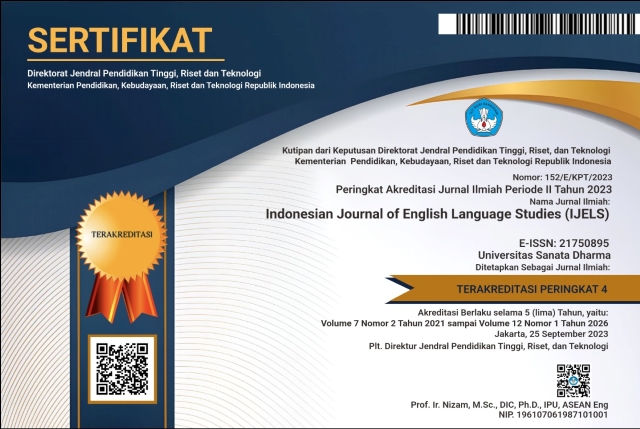English Language Education Students Perception of the Use of English Subtitled Movies
(1) Sanata Dharma University
(2) Sanata Dharma University
(*) Corresponding Author
Abstract
Keywords
Full Text:
PDFReferences
Albaum, G., Evangelista, F., & Medina, N. (1998). Role of response behavior theory in survey research: A cross-national study. Journal of Business Research, 42(2), 115-125.
Ary, D., Jacobs, L.C., & Sorensen, C. (2010). Introduction to research in education (8th ed.). Belmont: Wadsworth Cengage Learning
Altman, S., Valenzi, E., & Hodgetts, R.M. (1985). Organizational Behaviour: Theory and practice. Orlando: Academic Press, Inc.
Barratt, M. J., Ferris, J. A., & Lenton, S. (2015). Hidden populations, online purposive sampling, and external validity: Taking off the blindfold. Field Methods, 27(1), 3-21.
Carr, W. D., & Volberding, J. (2009). Sampling methods and the accredited population in athletic training education research. Athletic Training Education Journal, 4(2), 75-81.
Etikan, I., Musa, S. A., & Alkassim, R. S. (2016). Comparison of convenience sampling and purposive sampling. American journal of theoretical and applied statistics, 5(1), 1-4.
Febryanto, A. (2011). Microteaching Students Perception on the Implementation of Teaching Lower Semester Students in Developing Their Teaching Skills. Yogyakarta: English Language Education Study Program, Sanata Dharma University. Retrieved on November 5, 2019, from https://repository.usd.ac.id/
Gall, M. D., Gall, J. P., & Borg, W. R. (2007). Collecting research data with questionnaires and interviews. Educational research: An introduction, 12(10), 227-261.
Gorjian, B. (2014). The Effect of Movie Subtitling On Incidental Vocabulary. International Journal of Asian Social Science, 1014.
Griffiths, C., & Parr, J. M. (2001). Language-learning strategies: Theory and perception. ELT Journal, 55(3), 247-254.
Guarte, J. M., & Barrios, E. B. (2006). Estimation under purposive sampling. Communications in Statistics-Simulation and Computation, 35(2), 277-284.
Hayati, A., & Mohmedi, F. (2009). The effect of films with and without subtitles on listening comprehension of EFL learners. British Journal of Educational Technology, 183.
Kelly, A. E., Lesh, R. A., & Baek, J. Y. (Eds.). (2014). Handbook of design research methods in education: Innovations in science, technology, engineering, and mathematics learning and teaching. Routledge.
Koolstra, C. M., Peeters, A. L., & Spinhof, H. (2002). The pros and cons of dubbing and subtitling. European Journal of Communication, 17(3), 325-354.
Lowenberg, Peter H. (1991). English as an additional language in Indonesia. World Englishes, 10(2), 129.
Mackenzie, N., & Knipe, S. (2006). Research dilemmas: Paradigms, methods and methodology. Issues in educational research, 16(2), 193-205.
Muijs, D. (2004). Introduction to quantitative research. Doing quantitative research in education with SPSS, 1-12.
Munir, F. (2006). The Effectiveness of Teaching Vocabulary by Using Cartoon Film toward Vocabulary Mastery of EFL Students. Journal of English Language Teaching and Linguistics, 14-15.
Nasab, M., & Motlagh, S. (2009). Vocabulary learning promotion through english subtitled cartoons. Communication and Linguistics Studies, 3, 1-7
Nora, Theresia Noviani. (2012). ELESP Students Perception on Critical Reading and Writing 1 Course. Yogyakarta: English Language Education Study Program, Sanata Dharma University. Retrieved on November 5, 2019, from https://repository.usd.ac.id/
Ponty, M.M. (1974). Phenomenology of perception. (T. Honderich, Ed., & C. Smith, Trans.) New York: Routlede & Kegan Paul.
Rapita, Dwi. (2012). Students Peception on the Use of Blog in Basic Writing Class in English Language Education Study Program of Sanata Dharma University. Yogyakarta: English Language Education Study Program, Sanata Dharma University. Retrieved on November 5, 2019, from https://repository.usd.ac.id/
Rokni, S. J. A., & Ataee, A. J. (2014). Movies in EFL Classroom: With or Without Subtitles. The Dawn Journal, 3(1), 715-716.
Sari, A., & Sugandi, B. (2015). Teaching English Through English Movie: Advantages and Disadvantages. The Journal of English Literacy Education: The Teaching and Learning of English as a Foreign Language, 2(2), 10-15. Retrieved on October 10, 2019, from https://ejournal.unsri.ac.id/index.php/jenglish/article/view/2303
Silvia. (2009). Human Perception and Information Processing. Retrieved on October 10, 2019, from http://www.ifs.tuwien.ac.at/~silvia/wien/vu-infovis/articles/Chapter3_HumanPerceptionAndInformationProcessing_73-128.pdf
Szilagyi, A. D. (2007). Organizational behaviour and performance. Michigan University: Scott, Foresman.
Tull, D. S., & Albaum, G. S. (1973). Survey research: A decisional approach. Intext Educational Publishers.
Tull, D. S., & Albaum, G. S. (1977). Bias in random digit dialed surveys. The Public Opinion Quarterly, 41(3), 389-395.
Vanderplank, R. (1988). The value of teletext subtitles in language learning. ELT Journal 4(2), 272-281.
Wahyu Puspitaningtyas, Maria Vianney. (2018). Students Perception on the Use of Subtitled Video to Increase Their Motivation in Learning English: A Case in SMP Pangudi Luhur Moyudan. Yogyakarta: English Language Education, Department of Language and Arts Education, Faculty of Teachers Training and Education, Sanata Dharma University. Retrieved on November 5, 2019 from https://repository.usd.ac.id/
Wiersma. W. (1995). Research Methods in Education (6th Ed.). Boston: A Simon and Schuster Company.
Wiersma, W. (2013). The validity of surveys: Online and offline. Oxford Internet institute, 18(3), 321-340.
Zanon, N. T. (2006). Using Subtitles to Enhance Foreign Language Learning. Porta Linguarum, 6(4), 41-52.
DOI: https://doi.org/10.24071/ijels.v6i2.2824
Refbacks
- There are currently no refbacks.

This work is licensed under a Creative Commons Attribution-ShareAlike 4.0 International License.
IJELS Journal Sinta 4 Certificate (S4 = Level 4)
We would like to inform you that Indonesian Journal of English Language Studies (IJELS) has been nationally accredited Sinta 4 by the Ministry of Education, Culture, Research and Technology of the Republic of Indonesia based on the decree No. Surat Keputusan 152/E/KPT/2023. Validity for 5 years: Vol 7 No 2, 2021 till Vol 12 No 1, 2026

This work is licensed under CC BY-SA.
Creative Commons Attribution-ShareAlike 4.0 International License
IJELS e-ISSN 2715-0895; IJELS p-ISSN 2442-790X
Indonesian Journal of English Language Studies (IJELS) is published twice a year, namely in March and September, by the English Language Studies (ELS) of the Graduate Program of Sanata Dharma University, Yogyakarta, Indonesia.


 IJELS p-ISSN:
IJELS p-ISSN: 









